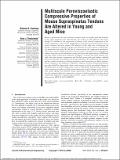Multiscale Poroviscoelastic Compressive Properties of Mouse Supraspinatus Tendons Are Altered in Young and Aged Mice
Author(s)
Connizzo, Brianne K; Grodzinsky, Alan J
Downloadbio_140_05_051002.pdf (2.375Mb)
PUBLISHER_POLICY
Publisher Policy
Article is made available in accordance with the publisher's policy and may be subject to US copyright law. Please refer to the publisher's site for terms of use.
Terms of use
Metadata
Show full item recordAbstract
Rotator cuff disorders are one of the most common causes of shoulder pain and disability in the aging population but, unfortunately, the etiology is still unknown. One factor thought to contribute to the progression of disease is the external compression of the rotator cuff tendons, which can be significantly increased by age-related changes such as muscle weakness and poor posture. The objective of this study was to investigate the baseline compressive response of tendon and determine how this response is altered during maturation and aging. We did this by characterizing the compressive mechanical, viscoelastic, and poroelastic properties of young, mature, and aged mouse supraspinatus tendons using macroscale indentation testing and nanoscale high-frequency AFM-based rheology testing. Using these multiscale techniques, we found that aged tendons were stiffer than their mature counterparts and that both young and aged tendons exhibited increased hydraulic permeability and energy dissipation. We hypothesize that regional and age-related variations in collagen morphology and organization are likely responsible for changes in the multiscale compressive response as these structural parameters may affect fluid flow. Importantly, these results suggest a role for age-related changes in the progression of tendon degeneration, and we hypothesize that decreased ability to resist compressive loading via fluid pressurization may result in damage to the extracellular matrix (ECM) and ultimately tendon degeneration. These studies provide insight into the regional multiscale compressive response of tendons and indicate that altered compressive properties in aging tendons may be a major contributor to overall tendon degeneration.
Date issued
2018-02Department
Massachusetts Institute of Technology. Center for Biomedical Engineering; Massachusetts Institute of Technology. Department of Biological Engineering; Massachusetts Institute of Technology. Department of Electrical Engineering and Computer Science; Massachusetts Institute of Technology. Department of Mechanical EngineeringJournal
Journal of Biomechanical Engineering
Publisher
ASME International
Citation
Connizzo, Brianne K., and Alan J. Grodzinsky. “Multiscale Poroviscoelastic Compressive Properties of Mouse Supraspinatus Tendons Are Altered in Young and Aged Mice.” Journal of Biomechanical Engineering 140, 5 (February 2018): 051002 © 2018 ASME
Version: Final published version
ISSN
0148-0731